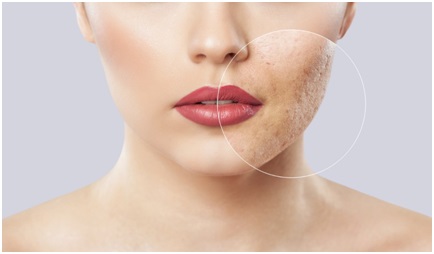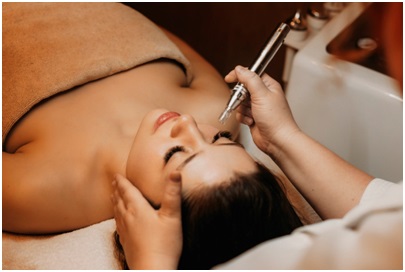Easily, the most common skin problem and condition worldwide is, unsurprisingly, acne. The spots and pimples are result from a chronic, inflammatory skin condition. Acne lesions can occur on the face, chest, shoulders, neck, back and upper arms. Almost every person has had puberty acne that has been expressed in a different way. Teenage acne lasts anywhere between five to ten years. Acne commonly occurs in adults as well. It is not dangerous, but it often leaves skin scars.
The main reason for scarring is the development of an inflammatory process involving multiple cells, chemical substances, and the bacterium called Propionibacterium acnes. Scars are response to trauma when the tissues under the skin are deeply damaged. The good news is that acne scars can be successfully treated.
In this article, we will look at what is acne, different types of acne scars, some home remedies for treating scars, and medical options for acne scar removal in Singapore.
What is acne?
Acne is considered as a normal part of the teenage years. One of the first signs of puberty is appearing of tiny red bumps. In acne, several factors work together. First, the sex hormone levels and adolescents fluctuate wildly. A birth control pill can help to even out these hormone levels in females. Second is abnormal shedding of dead skin that can clog the pores. The third factor is bacteria which proliferate and infect the skin.
Some people may develop more severe acne. Severe types involve whiteheads, red bumps and cysts. Most people develop only color changes in the skin and those go away on their own after some. Permanent scars are result from depressions in the skin or bumps in the skin which can cast a shadow. Squeezing is not considered to be helpful because it can increase the size of the scar.

Patients in aesthetic clinics like Cambridge Therapeutics often ask about natural treatments. Dermatologists tend to be very cautious about natural treatments because some especially those from plants can cause people to itchy and allergic. Nowadays more treatments than ever before are available to remove scars.
What types of acne scars are there?
Scars are the body’s response or over response to trauma. It’s can be acne or it’s can be picking from acne, or cuts. Certain chemicals and compounds are released by the acne bacteria that can make scarring worse. It can cause more inflammation and more skin destruction.
Collagen is the root cause of scarring. Collagen is a protein that naturally produces and gives the skin a lot of its strength. When the body produces too much collagen or too little collagen that can lead to scarring. Collagen is produced in specific cells inside of the skin called fibroids. Depending on how much collagen the fibroids produce depends a lot on genetics, the food, the antioxidant levels, and so on.
There are 3 main types of scars:
Atrophic scars
There are four main types of atrophic scars. Boxcar scars – these scars normally have pretty normal edges. They kind of look like a box. Ice pick scars – these are usually pretty deep set and a little bit jagged on the edges. Rolling scars – these are usually rigid on the edges and they have a varying depth.
Hypertrophic and keloid scars
These are scars where the body has had too much of a collagen response. That creates a raised bump on the skin. Keloid scars are probably the most extreme version. These are very large scars that usually have distinct shapes. These are the scars that happen if the person accidentally hurts the skin. It can happen with acne and on the face especially if the body is prone to it.
Post-inflammatory hyperpigmentation
Like sun damage, this is another type of pigmentation that usually occurs due to some form of damage to the skin. As it doesn’t cause harm to the follicle, it isn’t considered a form of scarring.
Scars can also come in a variety of colors. They can be clear, white, red or purple.

Dermatological treatments for acne scars
Chemical Peels
It’s a topical treatment and it exfoliates the outer layer of the skin to improve skin texture or pigment or tone . It also allows new, healthy fresh skin to replace that skin that has had removed. The procedure can improve the acne component of the skin as well as helping soften some of the old acne scars and damage.
Dermabrasion
It can be used to remove or lessen acne scars or pigmented discoloration. During a dermabrasion procedure, the skin is anesthetized or freezing is placed on the skin. The hand or electric-power instrument is used to remove the outermost layers of skin. In the common case of dermabrasion, the epidermis is removed and a thin portion of the dermis. The majority of the dermis remains so that the skin may heal without the scar. Over the following 5-10 days, new healthy skin grows in.
Dermal fillers
Fillers can be used to fill up space within the tissue that is treating. The dermal fillers are used to increase volume and to improve and eliminate the scarring.
Laser therapy
This method peels away the outer skin layers and while at the same time enhances the production of collagen in the deeper layers thanks to high-energy light.
Microneedling
Micro-needling is known as collagen induction therapy. It is a non-invasive procedure balances the skin tone and shrinks the size of the pores, wrinkles, and scars. Microneedling is a safe procedure which is applicable to all types of skin.
Home treatments
Some home remedies that can also help eliminate dark spots and acne scars.
- Aloe Vera. It consists antioxidants and natural astringent that reduce dead cells and redness.
- Coconut oil. It’s rich in omega fatty acids which can restore the skin’s glow.
- Its natural moisturizing effects and stimulation of tissue regeneration.
- This can weaken scar tissue and reduce the height of the scars.
There are many different ways for acne scars removal. The best way to be sure you are treating right your skin is to see a dermatologist.

